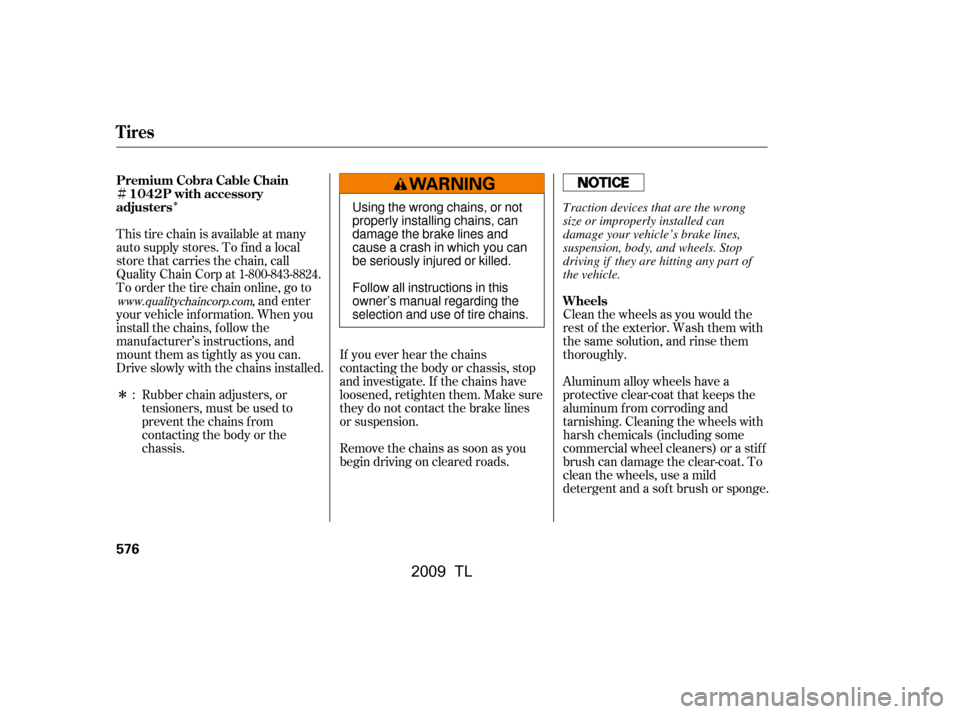Page 499 of 648

Some examples are:Larger or smaller wheels and tires
can interf ere with the operation of
your vehicle’s anti-lock brakes and
other systems.
Removing parts f rom your vehicle,
or replacing components with non-
Acura components could seriously
af f ect your vehicle’s handling,
stability, and reliability.
Lowering your vehicle with a
non-Acura suspension kit that
signif icantly reduces ground
clearance can allow the
undercarriage to hit speed bumps
or other raised objects, which
could cause the airbags to deploy.
Raising your vehicle with a non-
Acura suspension kit can af f ect
the handling and stability. Modif ying your steering wheel or
any other part of your vehicle’s
safety features can make the
systems inef f ective.
If you plan to modif y your vehicle,
consult your dealer.
Non-Acura wheels, can cause
excessive stress on suspension
components and may not be
compatible with the tire pressure
monitoring system (TPMS).
Modif ying Your Vehicle
A ccessories and Modif ications
496
�\f���—�\f���—�����y�
����\f��������y���
�)� �����\f�\f�y�\f���\f�
�y
2009 TL
Page 547 of 648

�Î
�Î
�Ì �Ì �Î
�Î
�µ�µ
�Ì
�Î
�Î
Maintenance Minder
544
:
If the message ‘‘SERVICE DUE NOW’’ does not appear more than 12 months
after the display is reset, change the engine oil every year.
See information on maintenance and emissions warranty on page .
Independent of the maintenance messages on the multi-information
display, replace the brake fluid every 3 years.
Inspect idle speed every 160,000 miles (256,000 km).
Adjust the valves during service 3 if they are noisy.
NOTE:
2:
542
1:
SH-AWD only
Maintenance Main Items
Replace engine oil
Replace engine oil and oil filter
Inspect front and rear brakes
Check parking brake adjustment
Inspect these items: Tie rod ends, steering gear box, and boots
Suspension components
Driveshaft boots
Brake hoses and line (including ABS)
All fluid levels and condition of fluids
Exhaust system
Fuel lines and connections Maintenance Sub Items
Rotate tires
Replace air cleaner element If you drive in dusty conditions, replace every
15,000 miles (24,000 km).
Replace dust and pollen filter If you drive primarily in urban areas that have high
concentrations of soot in the air from industry and
from diesel-powered vehicles, replace every 15,000
miles (24,000 km).
Inspect drive belt
Replace transmission fluid
Replace transmission and transfer fluid
Replace spark plugs
Replace timing belt and inspect water pump If you drive regularly in very high temperatures (over
110°F, 43°C), or in very low temperatures (under20°F, 29°C), replace every 60,000 miles (U.S.)/
100,000 km (Canada).
Inspect valve clearance
Replace engine coolant
Replace rear differential fluid Driving in mountainous areas at very low vehicle
speeds results in higher level of mechanical (shear)
stress to fluid. This requires differential fluid changes
more frequently than recommended by the
maintenance minder. If you regularly drive your
vehicle under these conditions, have the differential
fluid changed at 7,500 miles (12,000 km), then every
15,000 miles (24,000 km).
A
B
Symbol
Symbol
3
4
5
1
2
61
1
2
2
Maintenance Minder
�\f���—�
���—�����y�
�\f�����������y���
�)� �����\f�\f�y�\f�������y
2009 TL
Page 579 of 648

�Ì
�Î�Î
Clean the wheels as you would the
rest of the exterior. Wash them with
thesamesolution,andrinsethem
thoroughly.
Aluminum alloy wheels have a
protective clear-coat that keeps the
aluminum f rom corroding and
tarnishing. Cleaning the wheels with
harsh chemicals (including some
commercial wheel cleaners) or a stif f
brush can damage the clear-coat. To
clean the wheels, use a mild
detergent and a sof t brush or sponge.
This tire chain is available at many
auto supply stores. To f ind a local
storethatcarriesthechain,call
Quality Chain Corp at 1-800-843-8824.
To order the tire chain online, go to
, and enter
your vehicle inf ormation. When you
install the chains, f ollow the
manuf acturer’s instructions, and
mount them as tightly as you can.
Drive slowly with the chains installed. If you ever hear the chains
contacting the body or chassis, stop
and investigate. If the chains have
loosened, retighten them. Make sure
they do not contact the brake lines
or suspension.
Removethechainsassoonasyou
begin driving on cleared roads.
Rubber chain adjusters, or
tensioners, must be used to
prevent the chains f rom
contacting the body or the
chassis.
:
www.qualitychaincorp.comWheels
Premium Cobra Cable Chain
1042P with accessory
adjusters
Tires
576
Using the wrong chains, or not
properly installing chains, can
damage the brake lines and
cause a crash in which you can
be seriously injured or killed.
Follow all instructions in this
owner’s manual regarding the
selection and use of tire chains. Traction devices that are the wrong
size or improperly installed can
damage your vehicle’s brake lines,
suspension, body, and wheels. Stop
driving if they are hitting any part of
the vehicle.
�\f���—�\f���—�����y�
����
��������y���
�)� �����\f�\f�y�\f�����
�y
2009 TL